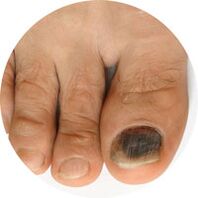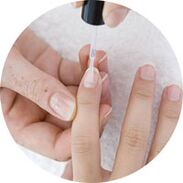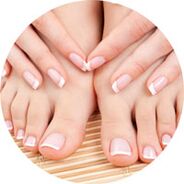Treatment of advanced forms of nail fungus takes more than a year. However, at the initial stage, the disease can be treated faster. To do this, created varnishes from the fungus of the nails on the hands and feet.
Treatment of fungal nails with varnish: indications and approach

Antifungal varnish is a tool that has recently gained relevance in the fight against nail fungus in the early stages of infection, that is, in cases where the plaque is less than 50% damaged.
The tool is convenient and practical: unlike ointments, it does not wipe off and is not washed off after drying.
However, antifungal nail polish is only indicated in 2 cases:
- At the initial stage of the disease, when up to 30% of the plaque is affected and no more than 3 nails on one leg, arm. With more extensive and deeper foci, antifungal tablets cannot be removed.
- For the prevention of onychomycosis. The coating reliably protects the nails from re-infection.
The drug can be prescribed for self-therapy or as part of a complex treatment.
How does antifungal varnish work?
Varnish for the treatment of nail fungus on the legs and hands has a liquid structure, is quickly absorbed and penetrates even into microcracks. The active substance begins to destroy the cell membrane, enzymes and spores of the pathogen. After curing, the coating clogs the plate, preventing oxygen from escaping. Left without a basis of vital activity, the mushrooms stop multiplying and gradually die.
Mycologists also prescribe a remedy for the prevention of fungus, especially for people who sweat excessively and after acrylic extensions. The resulting protective film prevents moisture, fungi and infections from entering the nail. In addition, alcohol, oils and plant extracts that go into the composition are disinfected and dried.
Treatment efficacy
Varnishes from nail fungus are effective only for the prevention and treatment of onychomycosis at the initial stage. The drug forms a protective coating, quickly eliminates the infection and prevents the appearance of a new one. Full recovery occurs after 3 months of treatment, the first results are noticeable after 7-10 days.
A few weeks after the end of treatment, it is necessary to pass tests. A lab test will show if the infection is completely cleared up and if a second treatment is needed.
Before buying any product, consult a mycologist or dermatologist. The specialist will assess the degree and depth of the lesion, determine the stage and prescribe a suitable varnish for nail or hand fungus.
How to apply varnish in the treatment of nail fungus?
The frequency of use of a particular tool is indicated in the instructions. As a rule, the first month the nails are varnished once every 2 days, the second - twice a week, the third - once a week. Therapy is performed until healthy plaque grows.

Lacquer against nail fungus on the legs and hands is applied according to the following scheme:
- Preliminary treatment. Before treatment, the feet or hands are steamed in a soda salt bath, thoroughly washed with soap and water. Then wipe down the surfaces and perform a hygienic pedicure or manicure. The nails are cut, the top layer is polished with a nail file and wiped with alcohol.
- Application of funds. Nail polish from the fungus is applied with a brush or spatula to dry patches. Actions are performed slowly and carefully so as not to injure the skin around. In this case, the composition should cover the entire surface of the nail.
- Post treatment. The applied drug should not be removed until the next procedure. However, after 10 minutes, after complete drying, decorative varnish can be applied over the healing varnish. If the manufacturer allows this possibility, this is indicated in the instructions.
Contraindications
Therapeutic nail polish from the fungus is not absorbed into the bloodstream and cannot cause poisoning. However, the remedy is contraindicated in:
- individual intolerance to components;
- propensity to allergic reactions;
- increased skin sensitivity;
- children under 16;
- Pregnancy and breast feeding.
Varnishes are prescribed with caution in diabetes mellitus, diseases of the immune system.
Side effects
Varnish for the treatment of fungal infections of the nails and hands rarely causes side effects. In case of accidental contact with the skin, it may manifest:
- burning;
- redness;
- peeling;
- swelling;
- irritation;
- itching.
In case of an allergic reaction, it is worth choosing an analogue with another active substance.
Warning! Fungal nail polish reduces the effectiveness of combined contraceptives.
Prevention

After complete recovery, the patient is often re-infected with the fungus. To avoid recurrences, it is necessary to cover the nails with varnish within a month after the end of treatment.
Particular attention should be paid to hygiene: washing hands and feet every day, changing socks, drying shoes. Towels and slippers must be individual.
Remember: even the best fungal nail polish requires regular application. Without retreatment, the coating will gradually peel off. As a result, there will be favorable soil for the development of fungi.
In conclusion, it must be said that in case of symptoms of nail damage by a fungal infection, and especially if this is accompanied by favorable factors, it is necessary to seek help from a qualified doctor.
Setting up experiments by self-selection of therapy means will not only not help in any way, but also aggravate the existing situation. To get a gift in the form of a fungus on the nails is very simple, but to cure it is quite difficult. Therapy takes a long time and is often complex, so you should not start the course of the disease with self-medication.





























